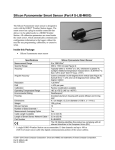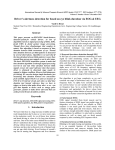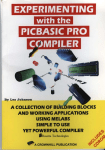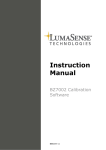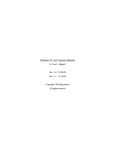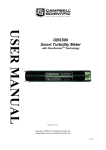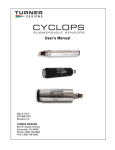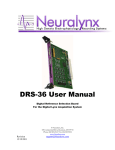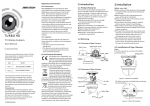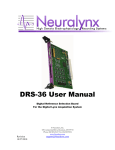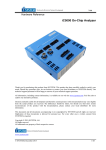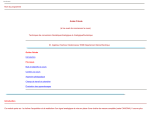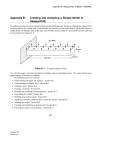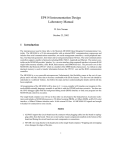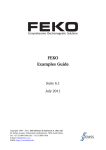Download USER MANUAL RAD — RADIOMETER ANALOG TO
Transcript
Remote Measurements & Research Company 214 Euclid Av. Seattle WA 98122 [email protected] RAD v9b USER MANUAL RAD — RADIOMETER ANALOG TO DIGITAL INTERFACE SW Version 17c — Manual Version 9b 6 June 2013 Contents 1 Introduction 3 2 Installation 4 3 Grounding the System 3.1 Grounding the SPP Radiometer . . . . . . . . . . . . . . . . . . . . . . . . . . . . . . . . . . . . . 7 8 4 Terminal Display & Commands 9 5 Case & Dome Thermistor Circuit 12 6 PIR Thermopile Circuit and Calibration Coefficients 13 7 PSP Thermopile Circuit and Calibration Coefficients 14 8 Calibration 15 9 Spot Checking Calibrations 18 10 Entering PSP and PIR Thermopile Calibrations 18 11 Important: back up the Configuration 18 12 References 19 A PSP Infrared Offset — -6 W m−2 at night is Okay 20 B SCHEMATICS 22 C PRINTED CIRCUIT BOARD 26 D RAD Box Hole Layout 29 E RAD User Menu 30 F Pipe Mount Base 32 6 June 2013 2 rad user manual v9b G Four Plug Configuration 32 H RS422 Operation 34 I 34 Ethernet Operation List of Figures 1 2 3 4 5 6 7 8 9 10 11 12 13 14 15 16 17 18 19 20 21 Mounting plate. . . . . . . Installation sketch. . . . . Three-plug wiring . . . . . Grounding the rad to the Grounds on the new PSP. Calibration circuit. . . . . Reference voltage source. . . . . . . . . . . . . . . . . . . . . . . . . . . . . . . . . . . . . . . . . . . . . . . . . . . . . . . . . . . . . . . . . . . . . . . . . . . . . . . . . . ship superstructure. . . . . . . . . . . . . . . . . . . . . . . . . . . . . . . . . . . . . . . . . . . . . . . . . . . . . . . . . . . . . . . . . . . . . . . . . . . . . . . . . . . . . . . . . . . . . . . . . Nighttime shortwave measurements. . . . . . . . . . . . . . . . . . . . . . . . The correlation between SW and PIR. . . . . . . . . . . . . . . . . . . . . . . The SW correction amount. . . . . . . . . . . . . . . . . . . . . . . . . . . . Compare raw and corrected SW on a typical night. . . . . . . . . . . . . . RAD schematic, analog-to-digital circuits. . . . . . . . . . . . . . . . . . . RAD schematic, analog-to-digital circuits. . . . . . . . . . . . . . . . . . . RAD schematic, analog-to-digital circuits. . . . . . . . . . . . . . . . . . . RAD schematic, analog-to-digital circuits. . . . . . . . . . . . . . . . . . . RAD printed circuit board, front view . . . . . . . . . . . . . . . . . . . . RAD printed circuit board, front view. . . . . . . . . . . . . . . . . . . . . Standard RAD box hole layout. Dimensions in mm. . . . . . . . . . . . . Standard RAD box with Ethernet option hole layout. Dimensions in mm. Pipe mounts. . . . . . . . . . . . . . . . . . . . . . . . . . . . . . . . . . . RAD wiring, 4-plug configuration . . . . . . . . . . . . . . . . . . . . . . . . . . . . . . . . . . . . . . . . . . . . . . . . . . . . . . . . . . . . . . . . . . . . . . . . . . . . . . . . . . . . . . . . . . . . . . . . . . . . . . . . . . . . . . . . . . . . . . . . . . . . . . . . . . . . . . . . . . . . . . . . . . . . . . . . . . . . . . . . . . . . . . . . . . . . . . . . . . . . . . . . . . . . . . . . . . . . . . . . . . . . . . . . . . . . . . . . . . . . . . . . . . . . . . . . . . . . . . . . . . . . . . . . . . . . . . . . . . . . . . . . . . . . . . . . . . . . . . . . . . . . . . . . . . . . . . . . 4 4 6 7 8 15 18 20 20 21 21 22 23 24 25 26 27 29 29 32 33 6 June 2013 1 rad user manual v9b 3 Introduction The Radiometer Analog-to-Digital converter (RAD) provides a robust, highly accurate conversion from shortwave and longwave radiometers to a calibrated serial stream (EIA232 or 422) in physical units. The RAD is mounted near the sensors to avoid electronic noise issues. The overall uncertainty of the RAD (10 sec average) is less than a few tenths W m−2 for either longwave or shortwave irradiance estimates. Thus RAD makes a negligible contribution to the overall measurement uncertainty. A photograph of the RAD system mounted on the R/V PISCES in Jan 2010. The PSP (Precision Spectral Pyranometer) and PIR (Precision Infrared Radiometer) are mounted on the top plate with cables coming down to the RAD processor. An in-field splice to a customer suppled cable connected RAD to the ship computer system. In this installation the wires were 22 gauge and the cable length was 76 m (250’) for power and RSS232, 9600 baud serial data. INPUT: Eppley PSP : thermopile voltage Eppley PIR : Thermopile voltage, Case thermistor, Dome Thermistor OUTPUT: See the output format ...HERE Shortwave irradiance ( W m−2 ) Longwave irradiance ( W m−2 ) Case temperature (C) Dome temperature (C) PIR thermopile voltage (mV) Board temperature (C) Input voltage (V) OUTPUT SERIAL: RS422 or RS-232 19200 bps, 8N1 NMEA comma separated fields. By combining careful grounding, close proximity pre-amplification, microprocessor technology, and quality analog-to-digital electronics the RadADC eliminates noise interference and allows for long cables between radiometers and data acquisition computers. New to this manual. (1) A more developed discussion of grounding can be found now in section 3. (2) The older 4-plug version of the RAD is NOT discussed in this and following manuals. Earlier manuals can be found online at RMRCO.com. (3) A discussion of the PSP infrared offset, most apparent at night when values of about -4 W m−2 are found. 6 June 2013 2 rad user manual v9b 4 Installation Figure 1: The PSP & PIR are mounted together on a AB plastic mount. The mounting pole is a standard 1.5” schedule 40 pipe (OD= 1.9”). Figure 2: Installation sketch. The RAD Control Data Unit here is a three plug version with the power and 3-wire RS232 in the same plug. (Go to Table of Contents) 6 June 2013 rad user manual v9b 5 Serial parameters Parameter Baud Start & stop bits Parity Flow control Setting 19200 bps 1 none none Connection to the Power Supply. As shown in figure 3 the power/serial cable is shielded. As long as the rad system is grounded as explained in section 3 it is recommended that this shield is left unconnected at the power supply. Thus there is a single grounding point. (Go to Table of Contents) 6 June 2013 6 rad user manual v9b EPPLEY PSP EPPLEY PIR P1 C2. Seven (7) conductors plus shield x 1 m (Provided) Amphenol PT06W-12-10S to Belden 8427 cable to Impulse MCIL-8-MP(w/LR). P2 C1 C2 P3 CABLES C1. Three (3) conductors plus shield x 1 m (Provided) Amphenol PT06W-8-4S to Belden 8414 cable to Impulse MCIL-4-MP(w/LR) C3. Five (5) conductor plus shield x 1 m (Provided) Impulse MCIL-6-MP (w/LR) to Belden 8425 x 1 m to open pigtails. P4 PLUGS P1. Amphenol (on PSP) P2. Amphenol (on PIR) P3. Impulse MCBH-4-FS P4. Impulse MCBH-8-FS P5. Impulse MCBH-6-FS RAD C3 CABLE C1 – PSP 4 6 1 2 3 2 3 5 1 MCIL-4MP View to Pins 4 1 SHIELD C - CASE 2 BLK A - PSP- 3 WHT B - PSP+ 4 MCIL-6MP View to Pins 1 CABLE TO RS232 CASE/SHIELD SHIELD 2 BLK PWR - (COMMON) WHT PWR+ 11--16 VDC 3 4 GRN RXD (DB9-2) 5 RED TXD (DB9-3) 6 BLU DGND (DB9-5) 8 7 1 CABLE C2 – PIR 2 3 4 6 5 MCIL-8MP View to Pins 1 SHIELD H CASE 2 WHT A PIR- 3 RED C PIR+ 4 GRN D TCASE+ 5 BLU E TCASE- 6 BRN F TDOME+ 7 YEL G TDOME- 8 ORN rad_wiring_3plug Figure 3: Three-plug wiring. 6 June 2013 3 rad user manual v9b 7 Grounding the System Figure 4: Grounding the rad to the ship superstructure. The grounding wire needs to make electrical contact to the ship superstructure. For a land installation the ground needs to be grounded to earth ground. radground How to Recognize Noise Problems Grounding is an important part of the installation. Ships are generally noisy (electronic noise) places and one can see the noise in the raw signals. The PIR amplifier gain is approximately 820 so noise is often apparent in time series plots of the PIR channel. Grounding As shown in figure 4 the ground strap needs to be in electrical contact with the ship superstructure, or Earth ground in a land installation. Note it might be necessary to scrape off some paint to get down to bare steel. For long term deployments, check the ground connection for corrosion or wear. Be sure the ground connection is clean. Each of the three rad cables are shielded. The shields connect to pin 1 of each connector and are connected to the rad case. The pir cable shield is connected to the pir connector pin H which is connected to case. For a standard psp, the shield is connected to psp pin C which is case. Section 3.1 describes grounding for the new style psp with an external ground wire. Checking for grounds Use a multimeter to check the continuity from the rad box to the ship or earth. As a final note, every application is different and grounding is not always necessary. But it is recommended. 6 June 2013 3.1 rad user manual v9b 8 Grounding the SPP Radiometer Figure 5: Grounds on the new PSP. Figure /ref3wiring Shows the wiring for the PSP as the thermopile (pins B & A) and a case connection (pin C). After serial number 37500, Eppley used a different wiring with the same thermopile (pins B & A) and then a case thermister (pins C & D). There is now NO case grounding. The new style radiometer is now called SPP The new style radiometers have a bright white body. We now have to ground the psp case by attaching a connection from the cable shield to the receptacle as shown in figure 5. This connection needs regular inspectionfor corrosion. (Go to Table of Contents) 6 June 2013 4 9 rad user manual v9b Terminal Display & Commands RAD start up display. RAD sends the following display on power up. After this sign-on display RAD enters the data collection mode. RAD SIGN ON MESSAGE *** RADIOMETER ANALOG TO DIGITAL INTERFACE (RAD) *** Software Version 1.17c, 2009,03,24 Digital Interface Board - Rev C. Feb 2009 Current EEPROM values: Identifier Header= $WIR02 PSP Coeff= 8.00E-6 PIR Coeff= 4.00E-6 Interval Time (secs)= 10 Cmax= 2048 Reference Resistor Case= 32958.0 Reference Resistor Dome= 33010.0 Vtherm= 4.0940, Vadc= 4.0940 PIR ADC Offset= 2.29 mv PIR ADC Gain= 836.34 PSP ADC Offset= 4.16 mv PSP ADC Gain= 118.02 Run Time Output The output data lines are written at the end of each averaging cycle. The analog-to-digital converter is read each 0.1 sec throughout the averaging period. Thus a 10-sec average will be an average of TYPICAL OUTPUT ID DATE TIME # PIR LW TCASE TDOME SW T-AVR BATT --------------------------------------------------------------------------------$WIR02,09/03/25,19:12:00, 76, -5.1, 447.34, 25.03, 24.98, 998.74, 28.4, 11.4 $WIR02,09/03/25,19:12:10, 175, -5.4, 446.67, 25.02, 24.99, 998.97, 28.5, 11.4 ... The date and time are read from the real time clock at the end of the averaging cycle, at the time of print out. During operation, the header can be printed by entering H at the keyboard. Output Variables ID DATE TIME # PIR LW TCASE TDOME SW T-AVR BATT NMEA-style tag. Set with ‘A’ command from menu. yy/MM/dd,hh:mm:ss. Set with ‘T’ command from menu. the number of samples that went into the averages. the average voltage from the PIR thermopile. the computed longwave downwelling irradiance the PIR case temperature the PIR dome temperature the computed shortwave downwelling irradiance. the temperature on the circuit board. the battery voltage after the input diode drop — GMT — millivolts W m−2 . ◦ C. ◦ C. W m−2 . ◦ C. volts. Measurement Error. Analog-to-voltage conversion noise is reduced significantly by averaging. The ADC sampling noise is typically 2 mV for the PSP circuit and 5 mV for the PIR circuit. The amplification gains for 6 June 2013 rad user manual v9b 10 these two signals are approximately 120 and 840 respectively. In a 10-sec averaging period the sample count (“#”) is about 175. The sensor gain for the two radiometers are approximately 8 µV/ W m−2 and 3 µV/ W m−2 respectively. Errors for the radiometers are √ (1) PSP error = 2 mv/120/ 175 = 1.2 µV √ PIR error = 5 mv/840/ 175 = 0.44 µV (2) (3) The measurement uncertainty (10-sec average) are typically 0.15 W m−2 for longwave or shortwave output. Main Menu. To stop data collection and go to the command menu, enter “T” (case sensitive). A prompt Command?> indicates the unit is in the command mode. Enter ? to see a menu of available commands. EEPROM variables are shown in parentheses. Typically on can make changes to existing eeprom variables or to the time by entering the designated letter and following the instructions. MAIN MENU WIR02 BOARD (REV B) VERSION: 1.17c, VERSION DATE: 2009,03,24 Digital Interface Board - Rev C. Feb 2009 Current datetime: 090325,191216 -----USER ENTER INFORMATION----------------------------’k’ -->Set PSP coefficient (8.00E-6 v/(W/m^2)) ’K’ -->Set PIR coefficient (4.00E-6 v/(W/m^2)) ’A’ -->Change Identifier String. (02) -----RAD CALIBRATION DATA--------------------------------’g’ -->Set PSP amplifier gain value. (118.0) ’o’ -->Set PSP amplifier offset, mv. (4.2 mv) ’G’ -->Set PIR amplifier gain value. (836.3) ’O’ -->Set PIR amplifier offset, mv. (2.3 mv) ’C’ -->Set Case 32958.0 ohms, -8.574e-5, 9.372e-2, -3.255e1 ’D’ -->Set Dome 33010.0 ohms, -3.648e-5, 3.990e-2, -1.494e1 ’V’ -->Set Thermistor Reference & ADC Reference Voltage (4.1 mV). Cmax = 2048 (fixed) ---------DATE & TIME SETTING-----------------------------’T’ -->Set the date/time. -----TIMING SETTING--------------------------------------’L’ -->Set averaging time in seconds. (10) -----OTHER-----------------------------------------------’S’ -->Sample 12 bit A to D. ’r’ --> toggle test mode. ’X’ -->Exit this menu, return to operation. ========================================================= Command?> The “USER ENTER INFORMATION” can be set in the field by the user. The radiometer coefficients are provided with the radiometers. The identifier string is a two character string at the end of the NMEA identifier. By NMEA 0183 convention, the record identifier has five characters. The first two characters are “WI” meaning weather instruments. The third character has been assigned to be “R” for radiation. The final two characters are user assigned via the user menu. This can be instrument serial number, e.g. “02”. Other options might be the experiment number. The “RAD CALIBRATION DATA” variables are set up during laboratory calibration with precision references. These should not be changed in the field. 6 June 2013 rad user manual v9b 11 Typical Menu Setup Example. If a new software hex file is uploaded to the RAD the entire list of parameters must be loaded into the EEPROM. The list below is used. Note that a special list is provided for each instrument and for each calibration. The list below is only an example. Set for each application. L 10 Averaging time in seconds. k 7.94e-6 PSP radiometer coefficient. K 3.94e-6 PIR radiometer coefficient. A 02 NMEA tag, final two characters. T 090324123400 yyMMddhhmmss date-time set real time clock. V 4.094 Reference voltage (TP16). Set From Lab Calibration g 118.02 PSP amplifier gain. o 4.16 PSP amplifier output offset. G 836.34 PIR amplifier gain. O 2.29 PSP amplifier output offset. C 0 32958 Case thermistor circuit reference resistor C 1 -8.574e-5 Case ADC correction parameter 1 C 2 9.372e-2 Case ADC correction parameter 2 C 3 -32.55 Case ADC correction parameter 3 D 0 33010 Dome thermistor circuit reference resistor. D 1 -3.648e-5 Dome ADC correction parameter 1 D 2 3.990e-2 Dome ADC correction parameter 2 D 3 -14.94 Dome ADC correction parameter 3 (Go to Table of Contents) 6 June 2013 5 12 rad user manual v9b Case & Dome Thermistor Circuit The PIR has a case and dome temperature thermistor. Both thermistors are made by YSI, and are of type 44031 (pdf). These are ±0.1◦ C interchangeable. See figure B for the thermistor circuit. The Max186 adc circuit has a reference voltage output, Vref , which is used in the thermistor circuits. The Max186 is operated in the bi-polar mode (mode = 0) giving it an input range of -2048 to 2047 mV. The reference resistors are approximately 33K ohms. The equation for the thermistor resistance independent of the reference voltage and is given by: c Rt = Rref (Cmax − c) where Rref is the reference resistor which is connected to Vref . c is the output count from the Max186 divided by 2, and Cmax is the maximum count of 4096. Note that c is corrected for the case and dome circuits as described in the section below. The thermistor resistance is converted to temperature using the Steinhart-Hart equation: x = C 0 + C 1 ρ + C 2 ρ3 1 − 273.15 x where C (3 × 1) are the Steinhart-Hart coefficients, [C] = [1.025579e − 03, 2.397338e − 04, 1.542038e − 07], and ρ is the log of the computed thermistor resistance, log(Rt ). T = Finally a small self-heating correction is subtracted as recommended by the manufacturer: T0 = T − Pt .004 where Pt = i2 Rt and i= Vadc − vt Rref CASE AND DOME TEMPERATURE CALIBRATION VALUES Three metal-film thermistors were selected and measured to high precision. Rcal 5621 9991 14966 vt 0.5961 0.9519 1.2798 T (◦ C) 39.861 25.022 15.208 Correction of the Thermistor ADC Conversion The value ADC count, c, is a corrected value. If the actual case and dome ADC counts are c0c and c0d , a quadratic correction yields cc cd 2 = c1 c0c + c2 c0c + c3 (4) = 2 d1 c0d (5) + d2 c0d + d3 (6) The parameters cc (i) and cd (i), i = 1, 2, 3 are determined during calibration and set in EEPROM. After application of this calibration correction, the computed temperatures agree with the standard thermistor table to better than 0.02 ◦ C. (Go to Table of Contents) 6 June 2013 6 13 rad user manual v9b PIR Thermopile Circuit and Calibration Coefficients The PIR thermopile output voltage, vpir , is related to the IR irradiance onto the thermopile under the glass dome. The PIR voltage is very small, typically a few microvolts, and must be multiplied in a preamplifier before being converted to a digital sample. The RAD microprocessor samples the ADC at approximately 70 Hz so a ten second output time will average approximately 670 instantaneous ADC samples. The ADC output is related to the PIR irradiance by the equation vadc − vof f Rp = 1000 G K where Rp is the thermopile irradiance, K is the radiometer calibration coefficient, vadc is the output of the ADC in millivolts, vof f is the amplifier offset in millivolts which should be very small, and G is the gain in the preamplifier circuit. A typical values for Kpir is 3 × 10−6 volts per W m−2 . The analog-to-digital circuit uses a Max186 ADC to convert preamplifier output voltage to an adc count by the equation c = Cmax vin vref where where vin is the input voltage, and Cmax is the ADC maximum count corresponding to an input of Vref . For a 12-bit ADC, Cmax = 4095 and for the Max186, vref = 4.095 volts. Therefore the output count is almost exactly the input in mV, vadc = c = vin . We refer to vadc as the measured ADC count in mV. As seen in figure B, the output of the PIR thermopile is treated as a differential voltage into an instrumentation amplifier (Burr-Brown INA2128). The resistor R5 determines the gain of the amplifier by the equation G = 1 + 50000/RG where where RG is the gain resistor, For the PIR thermopile circuit, RG = R5 ≈ 62 ohms and the amplifier gain would be approximately 807.45. Combining the above equations gives: (vadc − vof f ) 1000 G is the offset. vpir = where vadc = c is the output of the ADC and vof f Calibration of the thermopile circuit is made by applying small voltages, vpir , to the PIR input connector and measuring the output counts, vadc . The ADC instantaneous output is available with the ‘S’ command from the menu. After several samples press ‘enter’ and the mean and standard deviation for each channel is computed. A straight line fit is then used to determine G and vof f . G and vof f can be set in the menu with the ‘G’ and ’O’ options. The Albrecht-Cox relationship gives the downwelling IR irradiance 4 RLW ↓ = Rpir + σ TC4 − k σ (TD − TC4 ) where σ is the Stefan Boltzmann constant (5.6704 × 10−8 W m−2 K−4 ), TC is the case temperature in ◦ K, Td is the dome temperature in ◦ K, and k is a constant generally set to 4. The output data line provides the average value of RLW ↓ and the last measured instantaneous value for vadc . The vadc value will be somewhat noisy because it is an instantaneous reading. It is provided for purposes of quality assurance. It is best measured using the ‘S’ command as described above. There are a few simple tests by which one can evaluate the PIR performance. When a heat source is placed above the PIR, the thermopile signal should go positive. For example, put your hand over the dome – creating a 37◦ C blackbody. The output irradiance measured should be around 525 W m−2 . Next, (carefully) place something frozen from the freezer above the dome, creating a 0◦ C source and the irradiance should be approximately 315 W m−2 . (Go to Table of Contents) 6 June 2013 7 14 rad user manual v9b PSP Thermopile Circuit and Calibration Coefficients The PSP gain (provided from the manufacturer) is given by the equation vpsp = RSW ↓ k where RSW ↓ is the total downwelling shortwave irradiance, and k is the PSP gain. Typically k ≈ 8×10−6 volts per W m−2 . As above, the signal vpsp is amplified in the differential INA2128 and converted to an ADC count in the Max186. The combined output has a form of c = g vi + o where g is the combined gain for the amplifier and the ADC converter, and o is the offset in counts. For the PSP circuit, g ≈ 125. After trimming the circuit with zero input, o ≈ 2 mV. The precision ADC provides its own reference voltage so the Cmax = 4096 and Vref ≈ 4096 mv. After electronic calibration, the shortwave irradiance is given by RSW ↓ = c−o 1000 g 1 k where the divisor of 1000 converts mV to V to agree with the units of k. To determine the overall electronic gain one must make have at least two outputs from the instrument. Measure the out put of the PSP using a good voltmeter. Choose a time near midday when there are minimal clouds and there are no clouds covering the sun. Let v1 be the measured voltage from the PSP. Using the menu, and the S command, let c1 be the count with the same irradiance. A small time lapse is not a major source of error as long as the clouds are minimal. Next cover the PSP and measure the dark current ADC count (mV) with the S command. The count during dark conditions are c0 and v0 . The system gain equation is then g= c1 − c0 v1 − v0 generally the offsets are very low and can be neglected in the evaluation of g. As an alternative, a precision voltage source such as the Julie Lab “Volt-a-vider” can be used to fit a straight line to the gain equation. A field determination of c0 is usually a last task after installation. Nighttime offsets have been a major issues in the radiation community. A PSP will typically give -4 W m−2 at nighttime from the thermal differences in the PSP thermopile. (It is interesting to note that with a ventilator the output will go down to -6 W m−2 .) The radiation community has many different means to handle this offset. Generally the scientific community set the nighttime values, from sunset to sunrise, to zero during post processing. The daytime values are reported in realtime with v0 = 0 and c0 = 0. Then M = c1 /v1 . A final shortware irradiance is computed during post processing. 1 (Go to Table of Contents) 1 Personal communication with John Hickey, The Eppley Labs. 6 June 2013 8 15 rad user manual v9b Calibration Connections to the RAD circuit board are shown in Figure 6 below. The plugs are Tyco Ampmodu connectors. Two test plugs are used for checking and calibrating the board external to the weatherproof package. One plug provides power to the board and connects to a serial DTE computer. The second plug provides the four needed input signals: PSP, PIR, Tcase, and Tdome. The dashed boxes show the default test setup. With these the output PSP and PIR values (Section 4) will be near zero and the case and dome temperatures will be 25 ◦ C. The 610 ohm resistors simulate the output resistance of the two thermopiles. They should be left in the circuit during calibration. AMPU 2X5 Plug Female View of the back of the plug. +11-14 VDC - VDC DB9F (DCE) 2 - RD 3 - TD 5 - GND 2 1 4 3 6 5 8 7 PSP+ PSPPIR+ PIR- 610 Ω Test+ Test610 Ω Test+ Test- 10 KΩ 10 KΩ AMPU 2X4 Plug Female View of the back of the plug. rad803_plugs_test Figure 6: Connections for calibration of the RAD. Simple test cables with Ampmodu plugs can be plugged directly into the RAD circuit board. Voltage inputs range from ±2 millivolts. A set of precision resistors are used to simulate the case and dome thermistors. The RAD amplifiers are calibrated by using a precision millivolt reference source and a set of precision resistors to calibrate the thermistor divider circuit. The PSP thermopile calibration coeficients (g & o) and the PIR thermopile coefficients (G & O) are computed by fitting a straight line to a set of input voltages. The thermistor circuit calibration requires four coefficients, each for case and dome thermistors, that are derived from a set of precision resistances. The output from a calibration is shown in the text beginning on the next page. The full set of EEPROM coefficients is shown at the end of the calibration document. Each of these is set in the RAD as part of a full calibration. RAD is a relatively new instrument. Hence it is recommended that it be calibrated on an annual basis. We hope that with experience we will find that the amplifier calibrations will be much more stable so calibration intervals can be extended to two or even three years. (Go to Table of Contents) 6 June 2013 rad user manual v9b ======================================================= CALIBRATION RESULTS FOR RAD SN 206. CAL DATE = 2010-01-26. RUN TIME: 20100126,181909 setupfile: /Users/rmr/instruments/RAD/Cal/206_MossLanding/radcal_setup_206_100126.txt SN: 206 calpath: /Users/rmr/instruments/RAD/Cal/206_MossLanding caldate: 100126 Reference voltage = 4093.0 millivolts (TP16) PSPCAL -1.0, -120.40, 1.4 -0.5, -60.70, 1.8 -0.1, -13.15, 2.0 0.0, -0.71, 2.4 0.1, 11.24, 2.2 0.2, 22.58, 1.5 0.5, 58.48, 2.2 1.0, 117.75, 2.7 2.0, 237.20, 2.6 4.0, 474.70, 2.2 8.0, 950.08, 1.0 PIRCAL -2.0, -1682.80, 16.5 -1.0, -843.00, 11.0 -0.8, -674.00, 18.0 -0.4, -340.00, 12.0 -0.2, -172.50, 18.0 0.0, -6.00, 12.0 0.2, 165.40, 12.0 0.4, 332.00, 12.0 0.8, 663.00, 13.0 1.0, 835.00, 12.0 caseR 5600, 0.594, 594.80, 0.70, 39.92 10000, 0.952, 950.33, 0.60, 25.07 14974, 1.278, 1264.06, 0.70, 15.63 domeR 5621, 0.595, 595.50, 0.70, 40.00 10000, 0.953, 954.39, 0.80, 25.05 14974, 1.279, 1276.80, 0.40, 15.39 ==== CASE TEMPERATURE ======== Case Rref = 31260, Rref based on measurements of v_t = 32987. Error = -5.5 Case fit : -4.806e-05 6.731e-02 -2.223e+01 CASE THERMISTOR MILLIVOLTS Meas ADC ADC-Corrected 594.0 594.8 594.0 952.0 950.3 952.0 1278.0 1264.1 1278.0 CASE THERMISTOR OHMS CalR Meas 5600 5307 10000 9475 14974 14192 ADC ADC-corrected 5315 5307 9453 9475 13968 14192 CASE THERMISTOR CalR 39.96 25.00 15.24 ADC ADC-correc 41.37 41.41 26.40 26.34 16.88 16.51 DEG C Meas 41.41 26.34 16.51 Tout 39.92 25.07 15.63 ==== DOME TEMPERATURE ======== Dome Rref = 31200, Rref based on measurements of v_t = 32979. Error = -5.7 16 6 June 2013 rad user manual v9b Dome fit : -1.998e-05, 3.345e-02, 17 -1.233e+01 DOME THERMISTOR MILLIVOLTS Meas ADC ADC-Corrected 595.0 595.5 595.0 953.0 954.4 953.0 1279.0 1276.8 1279.0 DOME THERMISTOR OHMS CalR Meas 5621 5317 10000 9488 14974 14208 ADC 5322 9506 14173 DOME THERMISTOR CalR 39.86 25.00 15.24 ADC ADC-correc 41.34 41.36 26.26 26.31 16.54 16.48 DEG C Meas 41.36 26.31 16.48 ADC-corrected 5317 9488 14208 Tout 40.00 25.05 15.39 ==== PSP THERMOPILE CIRCUIT ======== PSP Calibration Gain (g) = 118.92, Offset (o) = -1.0 millivolts ==== PIR THERMOPILE CIRCUIT ======== PIR Calibration Gain (g) = 838.60, Offset (o) = -4.6 millivolts =============================================== RAD SETUP COMMANDS L : 10 k : 8.14e-6 (Eppley PSP cal) K : 4.27e-6 (Eppley PIR cal) A : 06 (Experiment or SN, 2 digits) V : 4093 C 0 : 32987 C 1 : -4.806e-05 C 2 : 6.731e-02 C 3 : -2.223e+01 D 0 : 32979 D 1 : -1.998e-05 D 2 : 3.345e-02 D 3 : -1.233e+01 g : 118.92 o : -1.05 G : 838.60 O : -4.57 (Go to Table of Contents) 6 June 2013 9 18 rad user manual v9b Spot Checking Calibrations A simple circuit can be used to spot check the RAD calibration. Figure 7: A simple spot calibration circuit diagram. The output of this circuit (Vpir ) will depend on the battery voltage but will be on the order of 0.3 mV. This circuit can be plugged into the PSP or PIR Amphenol connectors for a spot measurement to confim operation. 10 Entering PSP and PIR Thermopile Calibrations The RAD can be set for any different PSP or PIR by setting the calibration coefficients in the RAD menu. The radiometer calibration coefficients are determined by the manufacturer or by an equivalent facility. The calibration coefficient is a single number. The PSP coefficient is approximately 9 × 10−6 volts/ W m−2 . The calibration coefficient for the PIR is about 3 × 10−6 volts/ W m−2 . Enter the menu as described in this manual. Enter a ’k’ to change the PSP coefficient. Enter a ’K’ to change the PIR coefficient. Be sure to enter the coefficients with the ’e’ designator for powers of ten. For example ‘k’ might be entered as ‘8.45e-6’ and ‘K’ might be ‘3.23e-6’. 11 Important: back up the Configuration It is essential that you keep a complete copy of the configuration data. After entering or editing any configuration variables make an electronic copy. 1. SCREEN CAPTURE. Enter the ‘?’ command for a full dump. 2. Put your terminal program into capture mode and then enter ‘?’. (Go to Table of Contents) 6 June 2013 12 rad user manual v9b 19 References References Vignola, F., J. Michalsky, and T. Stoffel, Solar and Infrared Radiation Measurements, CRC Press, Boca Raton FL 33487, 2012. Younkin, K., and C. N. Long, Improved correction of IR loss in diffuse shortwave measurements: An ARM value-added product, Technical Report ARM TR-009 , DOE, Atmospheric Radiation Measurement program, Pacific Northwest National Laboratory, Richland Washington USA, 2003. (Go to Table of Contents) 6 June 2013 A 20 rad user manual v9b PSP Infrared Offset — -6 W m−2 at night is Okay The PSP thermopile is effected by an infrared radiation balance that leads to an offset on the order of -4 W m−2 [Vignola et al., 2012; Younkin and Long, 2003]. By way of example we will use data that was collected by a rad system during a comparison with the noaa reference radiation station in Boulder CO during April 2013. A description of the Boulder intercomparison can be found ...here. Figure 8 shows the PSP shortwave value during nighttime as defined by a solar zenith angle > 90◦ . We expect that nighttime illumination, from security lights, is negligible. The figure shows typical offsets of −2 to −4 W m−2 with excursions to as much as -10 W m−2 . Following advice from Joe Michalsky, NOAA (personal communication), we computed a fit between the PIR thermopile measurements and nighttime shortwave, figure 9. CORRELATE NIGHTTIME SW AND PIR 4 2013−04−12 (102) 01:35 to 2013−05−03 (123) 11:59 now = 2013−05−18, 09:32 2 2 0 NIGHTTIME SW 0 −2 −4 −2 −4 −6 −6 −8 −8 −10 −10 106 110 114 118 122 Figure 8: Nighttime shortwave measurements. −12 −400 CORRECTION = 0.0142 * PIR −0.69 W/m2 −350 −300 −250 −200 −150 NIGHTTIME PIR −100 −50 0 50 Figure 9: The correlation between SW and PIR. A fitted slope for this time series was C = −0.0142 Pi − 0.89 where C is the shortwave correction and Pi is the pir thermopile measurement reported by rad. The corrected shortwave irradiance is Rc = Rm − C where Rm is the measured shortwave irradiance (‘sw’) and Rc is the corrected irradiance. (Go to Table of Contents) 6 June 2013 21 rad user manual v9b Figure 10 compares Rm (blue) and Rc (red) for all nighttimes. Figure 11 shows a detail for one night. The corrected nighttime Rc are withing ±2 W m−2 and the mean value is approximately zero. 6 PSP RAW (blue), CORRECTED (red) NIGHTTIME W/M2 4 2 0 −2 −4 2 0 −2 −4 −6 −6 −8 −10 now = 2013−05−16, 18:19 4 now = 2013−05−18, 09:32 NIGHTTIME W/M2 6 2013−04−12 (102) 01:35 to 2013−05−03 (123) 11:59 PSP RAW (blue), CORRECTED (red) 2013−04−21 (111) 21:40 to 2013−04−22 (112) 17:37 106 110 114 HOUR Z 118 122 Figure 10: The SW correction amount. −8 22.0 0.0 2.0 4.0 6.0 8.0 10.0 12.0 14.0 16.0 HOUR Z Figure 11: Compare raw and corrected SW on a typical night. Real-time and Post Processing the Data The above analysis is based on having a full time series and developing the correlation after the fact, post-processing. For an on-going real-time data effort, post-processing is not reasonable. At this time (June 6, 2013), RMR Co is developing real time methods that can be applied to the RAD itself or possibly to the RAD data collection software. We expect to announce this soon. In the meantime, users are strongly encouraged to collect all ‘sw’ data and if error windows are applied, open the lower threshold to at least -10 W m−2 . (Go to Table of Contents) 6 June 2013 B 22 rad user manual v9b SCHEMATICS +VA -VA C2 1800pF 2 C1 .033uF 2 C4 1800pF 2 1 .033uF 1 1 1 2 C3 +VA 1 PSP STAGE 1 R1 100 R2 2 1 1 1 6 2 1 2 + VOA 6 - LTC1050 TH_DIP8 5 4 C10 1800pF 2 2 1 C11 1 2 C12 .01uF R6 100 1uF +VA A 2 A 2 1K SM_1206 1 1 C9 .033uF 1 A 3 R4 1K SM_1206 5 2 2 2 A TP4 TESTPOINT U2 7 7 INA118 C8 10pF 2 A +VA R3 8 +VA 1 3 4 2 2 1 1 1 C7 1uF RG2 V+ VOUT REF C6 .1uF 1uF 2 1 1 VINAVINA+ R5 10k RG1 V-IN V+IN V- TP1 TESTPOINT 1 C5 U1 1 PSP STAGE 2 2 5K TP3 TESTPOINT 1 TP2 TESTPOINT A -VA A R7 -VA A 1 2 10K SM_1206 R8 +VA 3 + 2 1 6 LTC1050 TH_DIP8 5 2 2 C25 .033uF 4 C24 .033uF 1 C23 1800pF 1 1 2 50K 2 2 100 2 1 1 7 1 1 R13 C19 1800pF C18 .033uF 2 2 3 U5 R10 R11 100 C17 1800pF 2 2 2 VR1 10K 2 -VA C16 .033uF 1 1 1 C21 .033uF C20 1800pF 2 -VA R9 100 1 2 1 50K 1 1 2 -VA A +VA -VA C28 .033uF 2 1 2 2 C27 1800pF 1 2 1 1 C26 .033uF C29 1800pF +VA 1 PIR STAGE 1 R15 100 PIR STAGE 2 2 R16 1 2 +VA 7 LTC1050 TH_DIP8 2 A -VA A A -VA 1 2 10K SM_1206 1 C48 .033uF 2 + C47 1800pF 1 2 2 3 2 1 1 C49 1800pF U16 6 - 1 5 4 1 C51 .033uF C50 1800pF C46 .033uF 2 7 3 1 100 1 2 2 C52 .033uF 2 2 R29 2 2 2 2 R26 1 1 1 1 +VA VR2 10K 2 1 VOB 6 - R22 +VA C45 .033uF C44 1800pF R25 100 R28 100 -VA + -VA 1 50K 2 5 1 2 2 2 1uF A R24 1 360 SM_1206 4 C37 1800pF 2 2 1 A 1 1 1 2 A U13 1 2 2 +VA A 3 R19 1 C36 .033uF C38 R21 100 TP12 TESTPOINT 2 1K SM_1206 INA118 C39 .01uF A R18 1 1 C35 10pF RG2 V+ VOUT REF 8 7 6 5 2 C34 1uF RG1 V-IN V+IN V- TP11 TESTPOINT 2 1 1 1 R20 10k 2 1 1 VINBVINB+ C31 .1uF C30 1uF U12 1 2 3 4 1 TP10 TESTPOINT 1 TP9 TESTPOINT 1.8K LTC1050 TH_DIP8 rad408-1_recC_schem_amps 2 50K -VA A Figure 12: RAD schematic, analog-to-digital circuits. (Go to Table of Contents) 6 June 2013 23 rad user manual v9b Test Plug DCE DB9-F +VIN 1 2 2A TH_RN55_UPRIGHT VIN 1 8 IN OUT C13 4.7uF SM/CT_3216_12 VCC 3 C14 .1uF SM_1206 TH_TO220 2 SA14 MELF 1 D2 14V C15 4.7uF SM/CT_3216_12 9 10 CON10 AMPM5X2 1 U8 2 O O O O G EMIFILTER U9 I 2 G G 3 3 3 3 TXD1 EMIFILTER I 2 EMIFILTER U7 I I U6 1 1 1 EMIFILTER G RXD1 TP6 TESTPOINT TP8 TESTPOINT 2 1N5819 MELF 7 2 TP7 TESTPOINT 1 EMIFILTER 5 6 2 10 4 U4 LM7805CT GND 9 VCC 2 7 8 2 3 D1 1 6 3 O 1 5 I 2 3 4 1 2 2 1 G 1 MAIN POWER IN (+9 VDC NOMINAL) U3 1 J2 1 2 3 4 5 F1 TP5 TESTPOINT RXD0 TXD0 1 1 1 A +VIN 1 +VIN U11 LM7812 R33 470 SM_1206 TH_TO220 VIN VOUT 2 1 GND 1 2 C32 4.7uF SM/CT_3216_12 D4 LED SM/C_1206A POWER LED 3 2 C33 4.7uF SM/CT_3216_12 21 1 2 TP13 TESTPOINT VCC 1 2 2 7 3 7 TP15 TESTPOINT 8 5 LM79L05ACM 2 C40 .1uF SM_1206 +VA 2 3 4 C57 .1uF SM_1206 1 U18 RESET MONITOR VCC RESET 3 2 ZM33064 TO261AA/SOT223 RESET 2 GND LM78L05ACM C56 4.7uF SM/CT_3216_12 2 SM/CT_3216_12 C42 4.7uF SM/CT_3216_12 VCC 1 1 5 4 1 6 C41 4.7uF SM/CT_3216_12 -VA 1 2 1 2 1 7 C55 4.7uF Vin Vout Gnd Gnd Gnd Gnd N/C N/C 6 3 U17 8 -Vin Output -Vin NC -Vin NC -Vin Gnd 1 6 TP14 TESTPOINT NEG ANALOG SUPPLY U15 5 LT1054 DIP8\SO POS ANALOG SUPPLY +VIN VOUT OSC VREF GND 2 2 4 1 C43 100uF CAPELEC 1 VIN FB/SD CAP+ CAP- 1 8 1 R23 100K SM_1206 U14 S1 PBSW RESET SW PUSHBUTTON 1 rad408-2_revC_pwr Figure 13: RAD schematic, analog-to-digital circuits. (Go to Table of Contents) 6 June 2013 24 rad user manual v9b PSP/PIR INPUT J4 1 2 3 4 5 6 7 8 PSP+ PSPPIR+ PIRRcase Rcase Rdome Rdome CON8 AMPM4X2 R36A 100K SM_DIP16\SOMC 6 5 4 3 2 1 EMIFILTER G U24 2 EMIFILTER U25 G EMIFILTER 2 U26 G EMIFILTER I 2 I U23 1 EMIFILTER G 1 2 I U22 1 EMIFILTER G I 2 1 U21 G I 2 I U20 G 1 EMIFILTER I I 2 U27 G O O 3 3 3 3 3 3 3 3 O O O O O O 11 12 13 14 15 16 2 1 1 EMIFILTER 1 A VCC 12-BIT A/D U29 VINA+ CH2 VINB+ Tcase TP16 JP1 A JP2 JUMPER 1 JUMPER 1 C66 C67 4.7uF 2 2 10uF SM/CT_3528_12 Tdome 2 2 VREF CH3 1 2 2 2 C77 4.7uF A 1 -VA VINB- 13 A VREF VINA- 14 MAX186 DIP20\SOL CASE/DOME THERM C65 .1uF 2 4.7uF MISO 15 12 11 VREF C64 .1uF 2 REFADJ A 1 AGND VSS 1 DOUT DGND CH7 %%oSHDN%%o C63 16 SSTRB CH5 CH6 8 10 SCK CSMOSI 19 18 17 1 R39 33K SM_1206 DIN CH4 7 ASHDN- R37 1M SM_1206 1 1 R38 33K SM_1206 5 6 9 2 SCLK %%oCS%%o CH3 A 20 VDD CH1 CH2 4 1 VCC CH0 2 3 2 1 1 1 VOA VOB CH2 CH3 CH4 CH5 CH6 CH7 A A J5 8 7 6 5 FILTERING INPUT CH7 t R35 R SM_1206 2 O G BOARD TEMP RT1 Thermistor RAD/CK05 2 2 R32 R SM_1206 EMIFILTER SM_EMIFILTER U37 1 I G CH6 VREF MONITOR 1 1 1 2 O G EMIFILTER U36 I 2 O O G 1 2 EMIFILTER U35 I U34 I G EMIFILTER 1 1 2 O G EMIFILTER U33 I 2 O O O G 1 2 EMIFILTER U32 I U31 I I G 1 1 1 2 EMIFILTER 2 CH5 U30 BATT VOLTAGE R34 R SM_1206 2 2 CON8 AMPM4X2 +VIN R31 10K SM_1206 R30 R SM_1206 1 2 1 EMIFILTER VREF VREF 1 3 1 4 2 3 3 3 3 3 3 3 3 J6 1 2 3 4 5 FILTERING OUTPUT A 6 7 8 CON8 AMPM4X2 rad408-3_revC_schem_io Figure 14: RAD schematic, analog-to-digital circuits. (Go to Table of Contents) 6 June 2013 25 rad user manual v9b AVR PROG PORT AVR ISP/ STK200 VCC VCC J3 COM0_TXD SCK RESET C22 1 3 5 2 4 6 2 COM0_RXD 7 8 12 11 10 9 13 5 4 15 14 6 2 3 1 100nF TH_CK05 CON6A SIP\6P 10uH TH_RN55 L1 1 1M R12A 16 ADC0 ADC1 ADC2 ADC3 ADC4 ADC5 ADC6 ADC7 SM_DIP16\SOMC VCC REAL TIME CLOCK VCC +VA 1 U19 49 50 51 52 53 54 55 PA2(AD2) PA1(AD1) PA0(AD0) VCC GND PF7(ADC7/TDI) (SCK)PB1 PC3(A11) (MOSI)PB2 PC2(A10) (MISO)PB3 PC0(A8) PG1(RD-) (T2)PD7 (T1)PD6 (IC1)PD4 XTAL2 (OC1B)PB6 XTAL1 (OC1A)PB5 PC1(A9) (XCK1)PD5 (OC0)PB4 (SDA/INT1)PD1 PC4(A12) (TXD1/INT3)PD3 (SS-)PB0 (RXD1/INT2)PD2 PC5(A13) GND PG0(WR-) 48 47 46 45 44 43 42 41 40 39 38 37 36 35 ASHDN- 34 33 32 31 30 29 26 27 28 21 22 24 23 20 25 18 19 17 TXD0 RXD0 COM0_RXD COM0_TXD TX1 RX1 PF6(ADC6/TDO) (IC3/INT7)PE7 (SCL/INT0)PD0 PC6(A14) VCC RX1 TX1 C59 4.7uF SM/CT_3216_12 RESET 2 2 1 2 TXD1 RXD1 1 1 C61 4.7uF SM/CT_3216_12 16 15 14 13 12 11 10 9 PF5(ADC5/TMS) PC7(A15) RESET- 16 (OC3C/INT5)PE5 (T3/INT6)PE6 TOSC1/PG4 15 PA6(AD6) PG2(ALE) TOSC2/PG3 14 PA5(AD5) (OC3B/INT4)PE4 ATMega128 SM_TQFP_64 2 10uF SM/CT_3528_12 VCC GND T1OUT R1IN R1OUT T1IN T2IN R2OUT 56 13 PA4(AD4) PA7(AD7) C58 C1+ V+ C1C2+ C2VT2OUT R2IN 57 12 PF4(ADC4/TCK) 11 PF3(ADC3) 10 (XCK0/AIN0)PE2 PA3(AD3) (OC3A/AIN1)PE3 (OC2/OC1C)PB7 VCC U28 58 9 CSSCK MOSI MISO PB4 PB5 PB6 (TXD0/PDO)PE1 PF2(ADC2) 7 8 1 2 3 4 5 6 7 8 60 6 470 SM_1206 PEN(RXD0/PDI)PE0 PF1(ADC1) 3 PF0(ADC0) 2 4 1 AREF 2 2 GND 1 1 5 C60 4.7uF SM/CT_3216_12 59 U10 1 COM0_RXD COM0_TXD R17 2 AVCC BT1 3.3V 1 61 PB5 PB4 PB6 DS1302 SM_DIP8\SOL 62 8 7 6 5 2 VCC1 SCLK I/O -RESET 1 VCC2 XTAL1 XTAL2 GND 63 2 1 2 3 4 R14 1M SM_1206 64 Y2 32.768KHz 6pF TH_CRYSTAL VCC 2 R27 1 C62 1 10uF SM/CT_3528_12 MAX220 DIP16\SOL 1 TTL/RS232 2 Y1 10M SM_1206 2 1 1 2 2 8MHz TH_CRYSTAL C53 18pF TH_CK05 C54 18pF TH_CK05 rad408-4_revC_schem_cpu Figure 15: RAD schematic, analog-to-digital circuits. (Go to Table of Contents) 6 June 2013 C 26 rad user manual v9b PRINTED CIRCUIT BOARD FUSE, 2A TP13 - Neg Stage 1 TP14 - Neg Analog supply TP15 - Pos Analog J5, FILTERING INPUT J6, FILTERING OUTPUT TP1 - PSP Amp 1 out TP2 - PSP - input TP3 - PSP + input TP4 - PSP Amp 2 out TP5 - +VIN (after diode) VR1 - Zero PSP Amp TP12 - PIR Amp 2 out AGND-DGND J4, PSP/PIR INPUT 1-2 PSP 3-4 PIR 5-6 Tcase 7-8 Tdome RESET TP11 - PIR Amp 1 out VR2 - Zero PIR amp Agnd for case & dome thermistors Program plug. (Adapter key up) R39 Dome Ref TP16 - VREF TP9 - PIR - input TP10 - PIR + input U24 case in U25 dome in rad406_pcb_revC_front Figure 16: RAD printed circuit board, front view (Go to Table of Contents) 6 June 2013 27 rad user manual v9b R12 - ADC input to ground R38 Case Ref rad407_pcb_revC_back Battery, Real-time clock (5-year) Figure 17: RAD printed circuit board, front view. (Go to Table of Contents) 6 June 2013 rad user manual v9b 28 MATLAB Computation function [lw, e, C_c, C_d] = RadTcTd2LW(v, G, O, K, tc, td, k); % %function [lw, e, C_c, C_d] = RadTcTd2LW(mv, G, O, K, tc, td); %---------------------------------------------------% %input % v = Rad ADC output in mV (typ -300 mv) % G = preamp gain (typ 825) % O = preamp offset (typ < 20 mv) % K = PIR calibration (typ 3.9e-6 V/W/m^2) % tc = case degC % td = dome degC % no arguments ==> test mode %output % lw = corrected longwave flux, W/m^2 % e = thermopile irradiance W/m^2 % C_c C_d = corrections for case and dome, w/m^2 %------------------------------------------------------%000928 changes eps to 0.98 per {fairall98} %010323 back to 1.0 per Fairall %100113 adapted from PirTcTd2LW.m k=4; % compute thermopile radiation e = (v-O)/G/1000/K; % THE CORRECTION IS BASED ON THE TEMPERATURES ONLY Tc = tc+273.15; Td = td+273.15; eps = 1; sigma = 5.67e-8; C_c = eps .* sigma .* Tc .^ 4; C_d = - k .* sigma .* (Td .^ 4 - Tc .^ 4); lw = e + C_c + C_d; return (Go to Table of Contents) 6 June 2013 D 29 rad user manual v9b RAD Box Hole Layout 25/64" Drill, 7/16-20 Tap 3x 132 100 28 18.35 60 160 rad_box_standard Figure 18: Standard RAD box hole layout. Dimensions in mm. 25/64" Drill, 7/16-20 Tap 3x 132 100 65 28 27 18.35 60 25.4 mm (1") Dia Thru hole. 1x 160 rad_box_ethernet Figure 19: Standard RAD box with Ethernet option hole layout. Dimensions in mm. (Go to Table of Contents) 6 June 2013 E rad user manual v9b RAD User Menu URI Settings L averaging time, SEC k PSP coef, v/(W/m^2) g PSP amp gain o PSP amp offset (mv) K PIR coef, v/(W/m^2) G PIR amp gain O PIR amp offset (mv) V ADC ref (volts) C PIR Case therm Rref (ohms) D PIR Dome therm Rref (ohms) A NMEA ID, RAD SN 10 8.48e-6 119.6 2.2 3.82e-6 842.3 8.2 4.072 33524 32782 01 CHECK OUT THE RAD CIRCUIT BOARD The RAD board can be checked out initially by the following check list: __ Serial number (e.g. SN 203) is written clearly on the board. __ The connector J4 is terminated across rows with the following resistors, top to bottom 600 ohms ______________ actual resistances 600 ohms ______________ 10K ohms ______________ 10K ohms _____________ __ Connect power and a terminal. (19200,8,N,1) Turn on the power. SW version = 17c Set the parameters to the following: L 10 k 8e-6 g 120 o 0 K 4e-6 G 840 O 0 V 4.072 Case thermistor, enter ’C’ then choose 0,1,2,or 3 C 0 : 33000 C 1 : 0 C 2 :0 C 3 : 0 Dome thermistor, enter ’C’ then choose 0,1,2,or 3 D 0 : 33000 D 1 : 0 D 2 : 0 D 3 : 0 A 00 __ Measure the following: TP5 Vin (12-14 VDC) ______________ TP13 (+5 v) ____________ TP14 (-5 v) ____________ TP15 (+5 v) ____________ 30 6 June 2013 rad user manual v9b 31 TP16 (vref 4.095 v) ____________ TP12 (PIR out zero to <+/-5 mV) ____________ TP4 (PSP out zero to <+/- 4 mV) ____________ U24 Case thermister in (951 mV) ____________ U25 dome thermister in (950 mV) ____________ U26 & U27 are wired to ground. __ Turn off power. Remove J4 connector. Resistance from TP16-U24 (Case Ref R, 33.00K) _____________ Resistance from TP16-U25 (Dome Ref R, 33.00K) _____________ (Go to Table of Contents) 6 June 2013 F rad user manual v9b 32 Pipe Mount Base Figure 20: Two different pipe mount fittings are available for 1.5” schedule 40/80 pipe. The top pipe mount bracket is made of heavy duty plastic. It’s fittings are threaded with helicoil inserts. The bottom fitting is 6061-T6 aluminum with thermoplastic powder coat. G Four Plug Configuration (Go to Table of Contents) 6 June 2013 rad user manual v9b Figure 21: RAD wiring, 4-plug configuration 33 6 June 2013 H rad user manual v9b 34 RS422 Operation The serial output for RAD is either RS422 or RS323 as selected by the customer. Both figures 3 and 21 show the option for either RS232 or RS422. RS4222 is good for very long cables (> 100 m) and/or high electronic noise situations. The standard nomenclature is used. RS232 and RS422 connector wiring convention. I Ethernet Operation An ethernet version of rad includes a serial server hub (ICP-DAS tDS3) The rad box hole diagram with the ethernet connector is shown in Figure 19. 2 American national standard ANSI/TIA/EIA-422-B (formerly RS-422) and its international equivalent ITU-T Recommendation V.11 (also known as X.27), are technical standards that specify the electrical characteristics of the balanced voltage digital interface circuit. RS422 provides for data transmission, using balanced or differential signaling, with unidirectional/non-reversible, terminated or non-terminated transmission lines, point to point, or multi-drop. Several key advantages offered by this standard include the differential receiver, a differential driver and data rates as high as 10 megabaud at 12 metres (40 ft). Maximum data rates are 10 Mbit/s at 12 m or 100 kbit/s at 1200 m. A common use of EIA-422 is for RS-232 extenders.


































